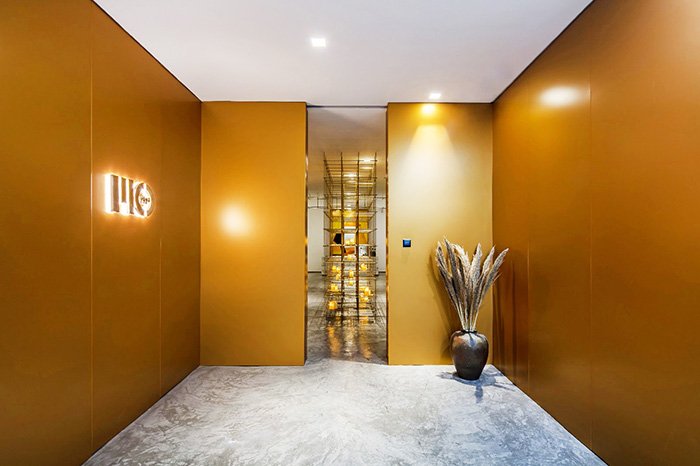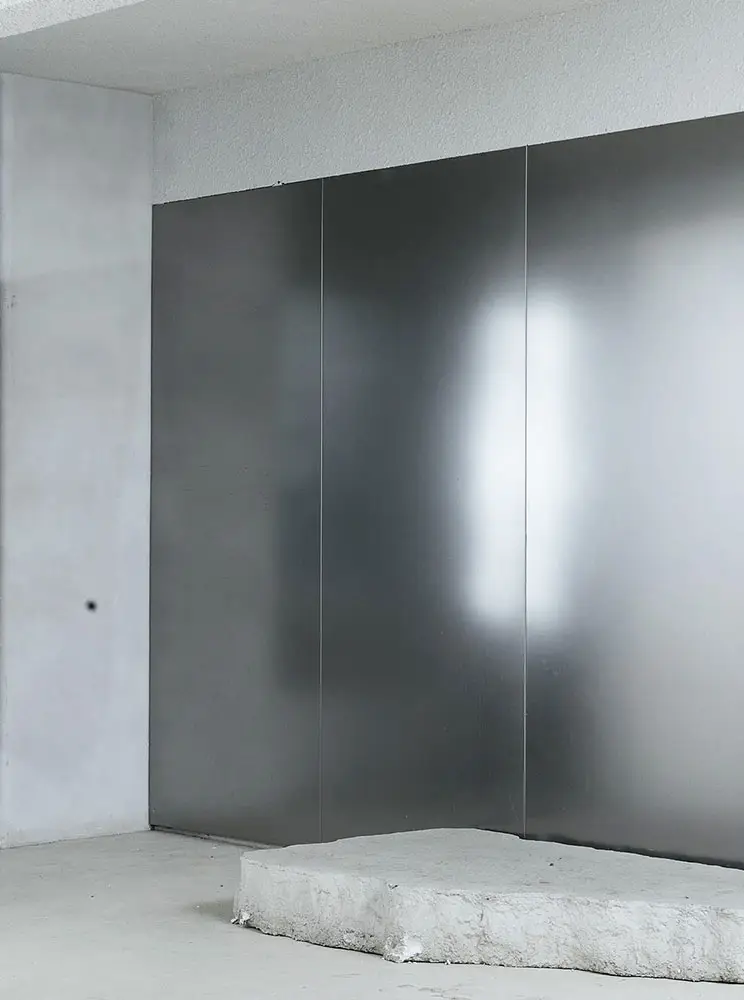Stainless Steel Sandblasted Metal Sheet
Stainless Steel Sandblasted Metal Sheet
201/304/316 stainless steel sandblasted metal sheet, whose surface effect is through the equipment to hit the sand particles on the stainless steel surface. The surface appears to form the surface granular sand surface, which can be thick or thin, dense or spare. After processing, the stainless steel sheet metal surface will be uniform, have a fine texture, and have an excellent aesthetic, adding a pleasing aesthetic. As a stainless steel sheets supplier, JYF Metal can carry out the PVD vacuum coloring process for metal sandblasting plates, making sandblasting titanium gold sheets, rose gold sheets, black titanium sandblasting sheets, and so on.
The sandblasted stainless steel plate surface is frosted and can do bright and matte. The light can also shine like stars, with a low-key connotation of the feeling. It is very suitable for post-modern style or luxury style decoration features.

Color Selection of
Stainless Steel Sandblasted Sheet
Stainless steel sandblasting plate can be SS201, SS304, or SS316. It can be done based on mirror sandblasting, and it can also be done directly on the 2B surface sandblasting, which is a strong sense of art decoration materials. The graininess makes the surface look more metallic. For applying more scenes, metal sandblasting sheets can vacuum PVD film. It can produce the color sandblasting board, titanium, rose gold, black, sapphire blue, and so on, bringing more choices for architectural decoration. Therefore, the sandblast finish series in high-end hotel design plays an important role. Many architects and designers on the project preferred the gold mirror sandblasted decorative panels.
Specification of
Stainless Steel Sandblasted Metal Sheet
Standard:JIS/AISI/ASTM/GB/DIN/EN
Type:Cold rolling
Thickness:0.3-3.0mm
Grade:201/304/316/430 etc…
Width:1000/1220/1500mm
Surface:Sand blasting
Length:Customizable (Max length:6000mm)
Color:Titanium gold, bronze, black titanium, rose gold etc…
Thickness tolerance:±4-5C
Application:Background wall, elevator interior, cladding
Service:Free sample, One stop service
Packaging:Waterproof paper + wooden case
How To Choose Material ?
Explore the various stainless steel materials offered by JYF Metal to find the ideal metal for your construction project. We will provide you with professional advice to ensure that the material you choose fully meets the specific requirements of your project. JYF Metal is committed to offering customized advice to ensure that the material you select is the most suitable.
Understanding Stainless Steel
Understanding Stainless Steel
SS201 VS. SS304 VS. SS316
SS201 VS. SS304 VS. SS316
Metal Sheets
Metal Sheets
various materials of
Stainless Steel Sandblasted Sheet
The collision of metal and sand particles creates a unique matte aesthetic. The sandblasting process coats stainless steel with a delicate coat, giving the cold material a warm and moist texture. Whether it’s the modern texture of building curtain walls or the texture expression of artistic installations, sandblasting technology redefines the sense of luxury in space with low-key luxury. When the sunlight brushes over the sandblasted surface, the metal no longer shines brightly, but instead redefines the texture aesthetics of modern space with a gentle halo.
201 stainless steel
Economic choice, suitable for dry indoor environments.
After sandblasting, it presents a uniform and delicate matte effect.
Typical applications: interior decorative lines, display racks, elevator interiors.
Attention: High humidity environment may affect surface stability.
304 stainless steel
Quality first choice, 8% nickel content ensures durability.
Sandblasting texture is more durable, with excellent anti fingerprint performance.
Perfect adaptation: building facades, high-end kitchens and bathrooms, seaside facilities.
Special advantage: Strong corrosion resistance, no discoloration for outdoor use
Material Selection Suggestions
- Budget based indoor project: 201 sandblasting board.
- Durability Quality Engineering: 304 Sandblasting Board.
- Strict environment: Consider 316 sandblasting board.
The sandblasting process allows stainless steel to retain its metallic essence while obtaining a gentle texture. Choosing the appropriate material according to the usage environment allows the matte aesthetic to last forever.
Application of Stainless Steel
Sandblasted Metal Sheet
Stainless steel sandblasted sheet metal represents a matte decorative surface finish. Sand is the key to improving the design. Often, the use of a gold sandblasting board in the entire space brings an advanced feeling that is very obvious. Sandblasting always reminds people of a lot of decorative inspiration and design ideas. Gold sandblasting particles always shine, so people can not help but stop to appreciate. Stainless steel mirror sandblasting plate enhances the sense of space and enlarges the visual space effect so that the room is more spacious and bright. Black titanium sandblasting board always has the aesthetic feeling of black pearl. It can also do blue and green sandblasting boards. Different color processing will bring an unexpected project effect.
Use of Stainless Steel
Sandblasted Metal Sheet
Industrial Sector
Stainless steel sandblasting plates are often used for surface treatment of mechanical equipment, industrial pipelines, pressure vessels, chemical equipment, etc. Sandblasting can remove surface oxide layers, rust, oil stains, and stains, making the surface smooth and providing better corrosion resistance.
Architectural Decoration
Stainless steel sandblasting boards are often used in the field of building decoration. It can be used as an outdoor wall material for building exterior decoration, providing aesthetics and modernity.
Home Supplies
Stainless steel sandblasting boards are also used in the manufacturing of household items, such as kitchen utensils, wash basins, bathroom accessories, etc. Through sandblasting treatment, the scratch resistance and wear resistance of stainless steel surfaces can be increased, and better tactile and appearance can be provided.
Artwork Production
As stainless steel sandblasting plate has good plasticity and toughness, it is often used to make artworks, such as sculpture, Installation artwork, etc. Sandblasting treatment can create unique texture effects on the surface of materials, increasing the aesthetic value of artworks.
Commercial Equipment And Display Counter
Stainless steel sandblasting boards are often used for the production of commercial equipment and display counters, such as supermarket shelves, display cabinets, bar counters, etc. Its appearance is exquisite, easy to clean and maintain.
Storage And Transportation Equipment
Stainless steel sandblasting plate plays an important role in storage and transportation equipment, such as logistics box, locker, Box truck, etc. Due to its corrosion resistance and high strength, it can ensure long-term service life.

Frequently Asked Questions
A1:Stainless steel sandblasted sheets are somewhat scratch-resistant, as the sandblasting process increases the surface roughness of the stainless steel, making it more wear-resistant.
A2:The surface of stainless steel sandblasted plate shows a fine texture similar to frosted, with soft gloss, stable color and comfortable hand feeling.
A3:Certainly, metal sandblasted panels can be custom manufactured according to specific customer requirements.
A4:When selecting stainless steel sandblasted panels for a project, consider the suitability of the material, the effect of surface treatment, cost, and environmental impact. Evaluate the material properties and surface quality to choose sandblasted panels that are cost-effective and environmentally friendly.
A5:These panels are widely used in construction projects, interior design, automotive parts, kitchen equipment, and decorative items. They are commonly used for wall cladding, elevator interiors, signage, furniture, and art installations.
A6:Sandblasting surface treatment is achieved by high-pressure blasting abrasive material onto the surface of the stainless steel panel. This process removes a thin layer of material, forming a textured surface with a matte appearance, characterized by a uniform pattern of small pits or indentations.

